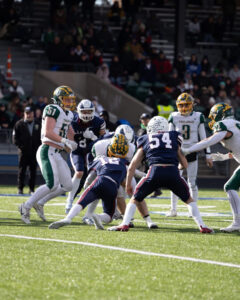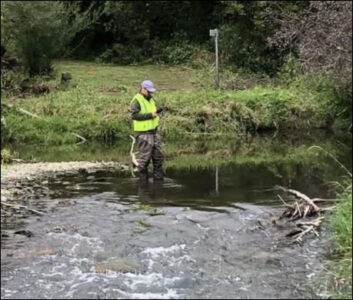Hunting For Muskies After The Sun Goes Down
Sportsman’s Journal
‘Tis the season to catch toothy critters — muskellunge.
Years of chasing muskies around have taught me and others many things, but the one thing that most can agree on: muskies are hard to catch during the dog days of summer.
Many years ago, I started getting requests for nighttime muskie fishing adventures. Quite honestly, I wasn’t really feeling the need or desire to chase these highly sought-after critters in darkness. It wasn’t until I had a conversation with what would soon be a good friend who explained to me how exciting it can be; plus the odds are in the angler’s favor once summertime air temperatures drop after sun down.
It was at this point that I began a new quest: how to catch muskies after the sun went down. It didn’t take me long to begin to understand the differences in daytime fishing and evening fishing. There are many similarities, but just as many differences.
This week we are going to discuss a little of what we have learned regarding catching these toothie critters in the dark.
First of all, night fishing for muskies can be very productive, but is often overlooked or not taken advantage of seriously by many anglers.
Muskies are a tough fish to catch in normal times, but on occasion being on the water after dark tips the odds in your favor. Yes, sometimes the best time to fish for trophy muskies on a particular lake is at night.
Where to go and how to find them are huge questions asked. Look for areas with vegetation. As muskie hunters, we fish areas like weed edges, points and humps that either contain rocks or weeds grow on. This can be no truer than during the summer, when muskies are holding tight to cover looking for their next meal, with little or no effort on their part.
These same areas are great for night fishing as well, but you might find that if the fish aren’t holding tight to the weed edges like they are in the summer, it’s most likely that they have bumped out farther from them in deeper and open water as the surface temperatures have cooled.
Running your bucktails and lures such as crankbaits have proven to be very effective at triggering muskies to eat after dark, so contacting vegetation while still keeping your lures clean of weeds is a great tactic.
Weedy areas that end on drop-offs and lead directly to deep water are prime areas for muskie fishing at any time. Like with weedy areas, drop-offs will always have muskies near them and are great areas when night fishing.
When you can’t find vegetation, drop-offs are a great area to search, and if it does have vegetation on the drop-off itself, you have found a new honey hole.
Rocky humps can be productive at times, and it never hurts to search for them, particularly in deep and clear water with fish like perch, sunfish and crappie. If there are any clumps of cabbage scattered on them, they should definitely be fished.
Personally, I do not spend much time in shallow bays, but that doesn’t mean there aren’t ever fish present there after dark.
If it’s close to deep water, it might not be a bad idea to go through the area with topwater bait.
With that being said, I have seen muskies in very shallow water after dark with a spotlight cruising in the shallows.
While there are many similarities between daytime fishing and nighttime fishing, there are many differences and safety measures that need to be taken. That goes without saying if you’re going to have little if any visibility. For this reason, you are going to need to prepare and bring certain pieces of gear, as well as take certain precautions.
Headlamps and lights like battery-operated lanterns and flashlights are a must in order to do things like change lures, tying fishing line and just to see in your boat.
Your boat should be free of any and all clutter from gear like rods and lures, especially on the deck as at night it’s easy to trip over these items and fall in the boat or go for a swim.
Safe navigation is also critical and you should have intimate knowledge of the body of water you are fishing on, or else you could hit a rock bar or encounter other treacherous water hazards.
The two main lures types that most muskie anglers use after dark are topwater lures and bucktails.
The reasoning behind these two lure choices is simple, topwater make a ton of noise on the surface and are easy to track, and topwater lures like creepers can be worked at a crawl and have the loud “bloop” noise.
Prop-style topwater lures work well, too, and throw a lot of water around while creating vibration and noise. They can also be worked at a variety of speeds.
Other lures like large crankbaits and even big rubber baits like magnum can work as well, so don’t be afraid to experiment when out on the water. Dark colors are almost always the best choice, and I and many anglers typically throw all black or mostly black lures to silhouette the best in the low light conditions. Other darker colors like purple and blue have also shown to work great on clear lakes where underwater visibility is a little higher.
Be sure to only use the lights when needed, and don’t fish with your headlamp on, as the light might scare away any following muskies.
Also make sure all boat batteries are fully charged and check their charge often. We have also installed an extra battery that is designed to just run the lights.
Long-nose pliers are a mandatory requirement for muskie fishing anytime day or night. It would be wise to have a couple of different types, including standard-length 8-inch pliers and a much longer one with more reach for deeply hooked fish.
Another mandatory tool in this department is a pair of hook cutters. All serious muskie anglers will have these in their boat, so if you don’t, you should.
Knipex hook cutters are what most muskie anglers prefer. They easily cut hooks that would otherwise seriously injure or kill a fish if they are yanked out with pliers. Also, while not mandatory, many anglers use a pair of armored gloves to protect their hands from the sharp gill raker teeth that are present in muskies. This is particularly a good idea if you aren’t experienced in handling them.
Night fishing, just like fishing muskies during the day, needs to be done with precision boat control and casting if you’re fishing properly. Boat control can be tricky during the day, depending on the layout of the lake. Now imagine doing it when it’s pitch black outside.
If you have fished the body of water during the day, you will soon realize it’s totally different in the dark. Often one cannot see shore, so you have lost your visual references. To find the weed lines, points, humps and drop-offs you have fished before, you will need a good GPS unit.
Not only should you drive slow and cautiously when going from spot to spot after dark, but you also want to slow down when fishing. Muskie angling during the daytime consists of fast-moving baits in many cases and covering water quickly to contact as many active fish as possible.
At night, fish have a hard time finding your bait and rely exclusively on their lateral line to hone in on bait, only seeing it when they are very close.
While this feeding activity isn’t any different than during the day, it’s easier for fish to see a silhouette, and thus track it in brighter conditions. At night, they can lose track of your lure far easier.
Due to it being dark out you will want to slow your retrieves down significantly and throw low and easy-to-track baits in most cases. While muskie anglers who do fish at night have preferred lure choices — we will discuss lures next — it’s important to note that any lure that works during the day will also work at night.
Muskie fishing at night can really give you an edge on what is otherwise a tough lake to fish.
Boating traffic is essentially nonexistent at night, and night fishing can be a great option on heavy traffic lakes during the weekend. If you are unsure if the muskie waters near you are good at night, there’s only one way to find out: get out after dark and fish.






